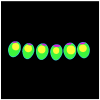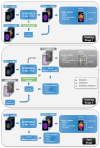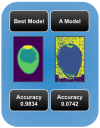Alternative Non-Destructive Approach for Estimating Morphometric Measurements of Chicken Eggs from Tomographic Images with Computer Vision
- PMID: 39766981
- PMCID: PMC11675178
- DOI: 10.3390/foods13244039
Alternative Non-Destructive Approach for Estimating Morphometric Measurements of Chicken Eggs from Tomographic Images with Computer Vision
Abstract
The egg has natural barriers that prevent microbiological contamination and promote food safety. The use of non-destructive methods to obtain morphometric measurements of chicken eggs has the potential to replace traditional invasive techniques, offering greater efficiency and accuracy. This paper aims to demonstrate that estimates derived from non-invasive approaches, such as 3D computed tomography (CT) image analysis, can be comparable to conventional destructive methods. To achieve this goal, two widely recognized deep learning architectures, U-Net 3D and Fully Convolutional Networks (FCN) 3D, were modeled to segment and analyze 3D CT images of chicken eggs. A dataset of real CT images was created and labeled, allowing the extraction of important morphometric measurements, including height, width, shell thickness, and volume. The models achieved an accuracy of up to 98.69%, demonstrating their effectiveness compared to results from manual measurements. These findings highlight the potential of CT image analysis, combined with deep learning, as a non-invasive alternative in industrial and research settings. This approach not only minimizes the need for invasive procedures but also offers a scalable and reliable method for egg quality assessment.
Keywords: 3D image segmentation; computer tomographic images; deep learning; eggs quality; morphometric data extraction; poultry.
Conflict of interest statement
The authors declare no conflicts of interest. And the funders had no role in the design of the study; in the collection, analyses, or interpretation of data; in the writing of the manuscript; or in the decision to publish the results.
Figures







Similar articles
-
Automatic Segmentation of Multiple Organs on 3D CT Images by Using Deep Learning Approaches.Adv Exp Med Biol. 2020;1213:135-147. doi: 10.1007/978-3-030-33128-3_9. Adv Exp Med Biol. 2020. PMID: 32030668 Review.
-
Segmentation of liver tumors with abdominal computed tomography using fully convolutional networks.J Xray Sci Technol. 2022;30(5):953-966. doi: 10.3233/XST-221194. J Xray Sci Technol. 2022. PMID: 35754254
-
Hybrid U-Net-based deep learning model for volume segmentation of lung nodules in CT images.Med Phys. 2022 Nov;49(11):7287-7302. doi: 10.1002/mp.15810. Epub 2022 Aug 17. Med Phys. 2022. PMID: 35717560 Free PMC article.
-
Two-stage deep learning model for fully automated pancreas segmentation on computed tomography: Comparison with intra-reader and inter-reader reliability at full and reduced radiation dose on an external dataset.Med Phys. 2021 May;48(5):2468-2481. doi: 10.1002/mp.14782. Epub 2021 Mar 16. Med Phys. 2021. PMID: 33595105
-
Non-Destructive Assessment of Chicken Egg Fertility.Sensors (Basel). 2020 Sep 28;20(19):5546. doi: 10.3390/s20195546. Sensors (Basel). 2020. PMID: 32998290 Free PMC article. Review.
References
-
- Chousalkar K.K., Khan S., McWhorter A.R. Microbial quality, safety and storage of eggs. Curr. Opin. Food Sci. 2021;38:91–95. doi: 10.1016/j.cofs.2020.10.022. - DOI
-
- Ketta M., Tumová E. Eggshell structure, measurements, and quality-affecting factors in laying hens: A review. Czech J. Anim. Sci. 2016;61:2016–2299. doi: 10.17221/46/2015-CJAS. - DOI
Grants and funding
LinkOut - more resources
Full Text Sources

